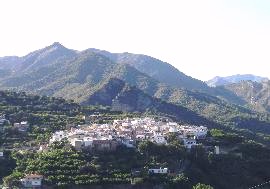 In recent years the search for an area of 'Real Spain' has become increasingly difficult to find as they are 'discovered' and undoubtedly soon change.
In recent years the search for an area of 'Real Spain' has become increasingly difficult to find as they are 'discovered' and undoubtedly soon change.
Now let me tell you about a fabulous hidden gem in Spain - 'Los Guajares'.
To find such an area today which is only 50 minutes from an international airport and only 20 minutes from the beach seems hard to believe but it's true.
Steeped in charm and marked in history, the valley, with its three villages, provides some of the most romantic rural settings in Southern Spain.
The villages of Guajar Alto, Guajar Faraguit and Guajar Fondon make up the municipality of Los Guajares, lying in a narrow valley that winds amongst orange, lemon, custard apple, avocado, almond and olive trees. Although it feels rugged and mountainous, its proximity to the coast provides a climate where the winters are warmer than areas further inland.
In Guajar Alto, with a population of just 290, there are four bars/ restaurants and a supermarket. There are also daily deliveries of bread, fruit and fish.
Guajar Faraguit, with a larger population of 700 residents, is the largest of the villages and from here you can clearly see the remains of the Moorish castle settlement that stood there centuries ago. The village has a supermarket, bakers, health centre and popular bar/restaurant. It is the administrative centre for Los Guajares which includes the town hall, primary and secondary schools.
Guajar Fondon, with a small population of just 240, is the lower of the three villages. It has a supermarket and a bar / restaurant on its outskirts.
The history of Los Guajares is steeped in the days of the Moors who called it Wa-run which means 'steep ground'. Faraguit, on the other hand, means 'hidden garden'. Its first settlers were Almohads, a Moorish tribe, and came under the jurisdiction of Motril and Salobreña.
The Guajares were eventually conquered by the Christians in 1568, 70 years after the fall of Granada. The area was handed over to 3 Christian nobleman. The Marquis of Mondujar was particularly cruel, with many Moors being thrown from the steep cliffs of the valley, often into the River Toba below - this river is still known by the locals as 'Rio Sangre' ('Blood River').
The area has many places of special interest. The highlight of the Guajares is 'El Castillejo', a 13th century Almohad fortified town which is in a well preserved state. In these days the valley was inhabited by farmers and producers of silk who retreated to this castle when protection was required.
In Guajar La Vieja, above Guajar Alto, there are remains of an old Moorish village with a necropolis and an Arab fortress.
Each village has its own ancient parish church, which are all well worth a visit.
Fondon has San Antonio de Padua, built in the early 17th century on the site of a mosque. It was burned down in 1571 by Moorish soldiers who killed the Christians who had taken refuge in it. In Faraguit there is the church of San Lorenzo built in the 16th century, again on the site of a mosque. It is built in Mudehar style with a baroque alterpiece. In Guajar Alto there is the church of our Lady of the Incarnation, also of the 16th century but was rebuilt in the aftermath of an earthquake, in the 19th century.
These sites, allied to the numerous traditional local fiestas, provide plenty of opportunities to soak up the flavour of the area.
So, if this is a hint of the Spain you are searching for perhaps you should consider discovering 'Los Guajares'.
Comments:
| There have been no comments submitted about this article yet. |